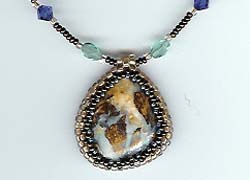Opal displays rainbow-like hues that have been prized for thousands of years . In the 1960s a team of Australian scientists analysed Opals with an electron microscope and discovered that small spheres of silica gel cause "interference and refraction manifestations". These spheres act on the light that passes through the gemstone and create the rainbow of colors that we see.
Almost ninety-five per cent of all fine opals come from the dry and remote outback deserts of Australia. Opals are often cut in cabochon, a rounded half-circle form, to best display their fire. The exceptions to this rule are the highly prized fire opals mined in Mexico, which have a warm, beautiful transparent red or golden color. Fire opals are sold in more traditional, faceted gemstone cuts and conventional settings.
Opals Love to be Worn
Opals always contain water – usually between 2 and 6 per cent, but sometimes even more. If stored too dry or exposed to heat over a period of time, Opals will show fissures and the play of colour will become paler. Therefore, Opal jewelry should be worn as often as possible, for then the gemstone will receive the needed humidity from the air and from the skin of its wearer.
Opals throughout history.
- In Australia, there is an Aborigine legend claiming the Opal sprung into being when the foot of the creator touched ground on a mission to bring peace to all human beings. The opals sparkle like the rainbow the creator walked on to visit the Earth.
- The Roman writer Pliny describes opals as a stone having "the fire of the carbuncle, the brilliant purple of the amethyst and the sea green color of the emerald, all shining together in incredible union."
- Shakespeare called opals "the queen of gems."
- An opal was set in the crown of the Holy Roman Emperor and in the crown jewels of France.
- Queen Victoria broke a 19th century stigma on opals by giving the gems as wedding gifts to many of her royal relatives.
- French actress Sarah Bernhard, whose birthday was in October, always wore birthstone opals, popularizing them at the turn of the 20th century.
Opal Folklore for Health
- Opals cure eye diseases and infections.
- Opals resolve depression.
- Dispel bad dreams with opals.
Other Opal Folklore
- Opals instill faithfulness, confidence and good luck to the wearer.
- Opals enhance creativity.
- For the lonely, Opal aids in the search for true love.
- Black opals worn near the heart protect against the evil eye.
- Wearing jewelry containing opal will focus the energies of Venus and the zodiac sign Libra through the gem to it's wearer.
- In the 15th century blond maidens valued nothing more highly than necklaces of opals, for to wear these ornaments their hair was sure to guard its beautiful color.
- And my personal favorite, it was thought to render the wearer invisible!
Opal as a gift.
- As the birthstone for October, it makes a great birthday gift. An alternate birthstone for October is Tourmaline.
- Opal is the birthstone for the zodiac sign Libra, making it appropriate for birthdays between September 23rd and October 23rd.
- It is the suggested gem gift for 14th and 18th year wedding anniversaries.
- It is the official gemstone of Australia. As such it could be a good gift for displaced Australians, a little piece of home, or a great souvenir for those who have visited Australia.

This photo is a boulder opal a friend of mine brought back from Australia. I created a beaded bezel for it using peyote stitch and seed beads. The necklace is strung seed beads, Swarovski crystal and Czech glass beads. I love how the pattern on this side of the opal is reminiscent of a waterfall.
If you've created anything using Opals, feel free to leave a link to it here.Sources:
Valuable Stones - The Online Encyclopedia of Gemstones, http://www.valuablestones.com/libra.htm.
Gem by Gem - International Colored Gemstone Association, http://www.gemstone.org/gem-by-gem/english/opal.html.
Precious Stones Guide vol. 9, http://www.jjkent.com/articles/history-folklore-opals.htm.

